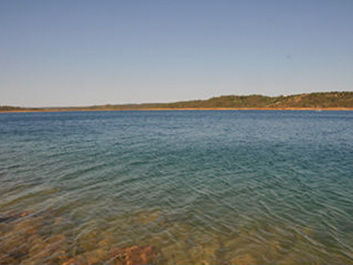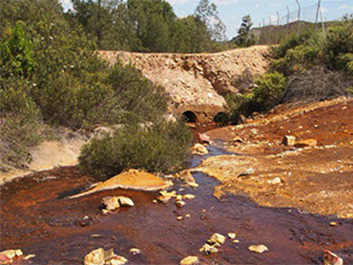Acid mine drainage
Acid mine drainage (AMD) is one of the main environmental problems associated with the oxidation of sulfides on Earth’s surface. The low pH of AMD (as low as 1.5) and its high metals concentration cause a very serious and persistent impact on aquatic and terrestrial environments.
![]()
The Iberian Pyrite Belt
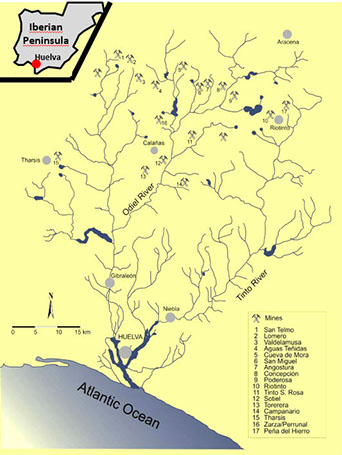
In Huelva (Spain), as result of the mining industry in the so called Iberian Pyrite Belt, massive deposits of sulfide minerals have been exposed to an oxidative atmosphere since the Roman times. The resulting AMD causes serious environmental problems in the Tinto and Odiel River basins and the Huelva Ria.
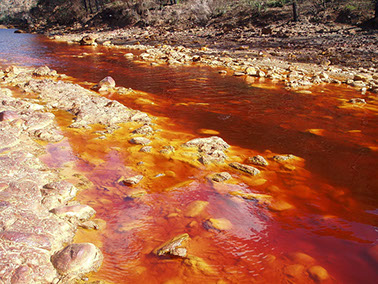

The historical persistence of AMD in the area has created a number of unique extreme environments where only well adapted microorganisms can survive. Many of these microorganisms use a wide variety of little studied metabolisms to obtain energy and nutrients for growth, while coping with the low pH and high heavy metal concentrations.
Importance of AMD studies
The study of these extreme environments is not only important in order to understand how AMD affects the environment and how these effects can be possibly prevented or reversed. It also represents an excellent opportunity for microbial ecologists and biogeochemists to find new types of microbial metabolisms and microorganisms that might have been important in the early evolution of life on our planet when extreme conditions prevailed. In addition, extremophilic microorganisms have a great, largely unexplored, biotechnological potential.
El Sancho reservoir
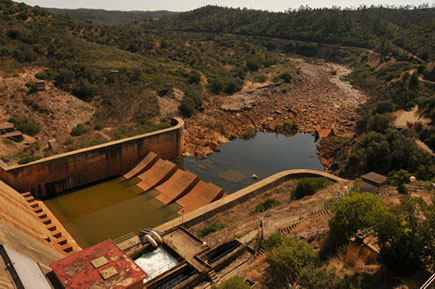
Our group has recently initiated the study of the microbial ecology and biogeochemistry in the water column and sediments of the Sancho Reservoir. This reservoir, originally with a neutral pH, has undergone a progressive acidification process over the last 20 years which has led to an acidic pH that oscillates between 3.5 in winter to 4.5 in summer.
Major objectives of our research is to analyse the changes induced by acidification to the microbial communities which inhabit the reservoir and to understand the interplay between purely geochemical and microbial-mediated processes that induce the observed increase in pH during summer stratification. Understanding the mechanism behind this seasonal natural attenuation may allow to implement in the future preventative and restoration strategies for aquatic media exposed to chronic AMD pollution.
Collaborations
Main collaborators from other labs include:
Carlos Ayora, IDAEA-CSIC, Barcelona, Spain
Ester Torres, IDAEA-CSIC, Barcelona, Spain
Jose Angel Galvez, Biology Department, University of Cádiz
Melquiades Casas, Applied Physics Department, University of Cádiz
Luis Barbero, Geology Department, University of Cádiz
Jose Miguel Nieto, Geology Department, University of Huelva
Manolo Olias, Geology Department, University of Huelva
Juan González, IRNAS-CSIC, Sevilla, Spain.
Juan Pedro Bolívar Raya, Applied Physics Department, University of Huelva
Publications (more here)
Torres E., Ayora C., Jiménez-Arias J.L., García-Robledo E., Papaspyrou S., Corzo A.(2014) Benthic metal fluxes and sediment diagenesis in a water reservoir affected by acid mine drainage: a laboratory experiment and reactive transport modeling. Geochimica et Cosmochimica Acta.
Torres, E., C. Ayora, C.R. Canovas, E. García-Robledo, L. Galván, A.M. Sarmiento (2013). Metal cycling during sediment early diagenesis in a water reservoir affected by acid mine drainage. Science of the Total Environment 461- 462: 416–429.
Torres, E., Ayora,, C., Jiménez-Arias, J.L., García-Robledo, E, Papaspyrou, S., Corzo, A. (2012). Early diagenesis modelling of sediments from a water reservoir affected by acid drainage. Macla. Revista de la Sociedad Española de Mineralogía. 16:136-137.
Conferences
Soria-Píriz, S.; García-Robledo, E.; Papaspyrou, S.; Úbeda, B.; Jíménez-Arias, J. L.; Bohórquez, J.; Gálvez, J. A.; Gómez, E. H.; Revsbech, N. P.; Corzo, A.: (2015) Ecology of a deep chlorophyll maximum developed during stratification in an acid mine drainage impacted reservoir (Huelva, Spain), 2015 Aquatic Sciences Meeting, 22-27 February, Granada, Spain
Torres E,. Ayora, C., Arias J.L., , García-Robledo,E, Papaspyrou, S., Corzo, A.(2013) Metal fluxes at the sediment-water interface in a reservoir affected by AMD. 2013 Goldschmidt, 25-30 August, Florence, Italy. (Oral).
Torres E., Ayora C., Arias J.L., García-Robledo E., Papaspyrou S., Corzo A. 2 (2012). Diffusion-reaction modelling of early diagenesis of sediments affected by acid mine drainage. European Geosciences Union meeting 22-27 April, Vienna, Austria.
Jimenez-Arias, JL., Torres, E., García-Robledo, E., Papaspyrou, S., Ayora, C., Corzo, A. (2011). Biogeocehmical changes in the sediment-water interface in reservoirs affected by acid mine drainage during transition from hypoxic to oxic conditions: a laboratory experiment. 20th International Symposium on Environmental Biogeochemistry (ISEB2011). Istambul (Turquía).
García-Robledo E, Papaspyrou S, Corzo A., Torres E, Ayora C, Jiménez-Arias J.L (2011). Benthic contribution to alkalinization in acid reservoirs: the influence of aerobic and anaerobic microbial processes in a laboratory experiment. International Society for Environmental Biogeochemistry 2011: Frontiers in Biogeochemistry, 27 – 30 September, Istanbul, Turkey (Oral)
Funding
“Interaction of the microbial and geochemical processes in the natural attenuation of the contamination caused by acid mine drainage in reservoirs and estuaries” (Interacción de los procesos microbianos y geoquímicos en la atenuación natural de la contaminación por drenaje acido de minas en embalses y estuaries), P11-RNM-7199, Andalucía Regional Government (186,280 €). PI: Prof. A. Corzo, University of Cádiz.

